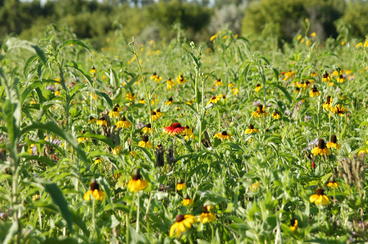
Challenge: Winter climate change is occurring more rapidly and may affect prairie habitat restoration outcomes.
Principal Investigator(s):
- Ellen Damschen (University of Wisconsin-Madison)
Co-Investigator(s):
- Christopher Warneke (University of Wisconsin)
Cooperator/Partner(s):
- Richard Henderson (The Prairie Enthusiasts)
- Hannah Spaul (The Nature Conservancy)
- Nicholas Miller (The Nature Conservancy)
- Matthew Zine (Wisconsin Department of Natural Resources)
- Drew Feldkirchner (Wisconsin Department of Natural Resources)
- Evelyn Williams (Adaptive Restoration, LLC)
- Mike Healy (Adaptive Restoration, LLC)
- Michelle Homann (Univ. of Wisconsin-Madison)
- Katherine Charton (Univ. of Wisconsin-Madison)
The prairie grasslands of the Midwest and Great Plains provide important habitat for a wide variety of plants and animals, clean drinking water, and space for outdoor recreation and have experienced an over 99% loss of prairie grasslands due to a variety of factors including climate change. Land managers that are working to restore prairie grasslands would like to make them resilient to a shifting climate. However, they have limited information about how to plan these restorations with climate adaptation in mind In the Midwest and throughout much of North America, the effects of climate change are more pronounced and rapid in winter than in other seasons. Winters generally have less snow leaving plants more exposed and vulnerable to damage from freezing temperatures due to the lack of snow cover. Land managers use prescribed fire and mowing as management tools to help maintain the open structure of grasslands and prairies which can also affect how resilient restored prairie grasslands are to climate change across the seasons.
Working with land management partners, researchers are planning to use different management tools (mowing, prescribed fire) during different seasons (spring, fall) across simulated future climate conditions (through modifying the amount of snow cover in winter) to a restored prairie in southern Wisconsin to examine how the plant community there responds. By measuring which types of plants go locally extinct and whether the remaining plant populations grow or shrink, the researchers will be able to provide managers with information about when and which tools they could use to aide in their prairie restoration efforts. The research team will share their findings with land managers who are working towards building climate change resilient prairies for the benefit of wildlife and communities.
Working with land management partners, researchers are planning to use different management tools (mowing, prescribed fire) during different seasons (spring, fall) across simulated future climate conditions (through modifying the amount of snow cover in winter) to a restored prairie in southern Wisconsin to examine how the plant community there responds. By measuring which types of plants go locally extinct and whether the remaining plant populations grow or shrink, the researchers will be able to provide managers with information about when and which tools they could use to aide in their prairie restoration efforts. The research team will share their findings with land managers who are working towards building climate change resilient prairies for the benefit of wildlife and communities.
Read more from the CASC Project Explorer.
Project Details
Principal Investigator
Ellen Damschen
Principal Investigator Organization
University of Wisconsin-Madison
Year
2023
Topic
Landscapes,
Science Tools for Managers
Status
In Progress
